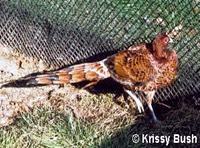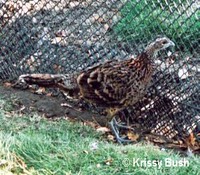COPPER PHEASANTS
By Donna Bush, Devon, AB
When I was asked to write an article on Copper pheasants, I realized very little had been written about these beautiful birds, and basically all the information portrayed them as savage, extremely difficult to raise species. My experience over the past twenty years has proven just the opposite. Although I did have some problems in the beginning with vicious cocks, and went through a period of needlessly replacing several hens. Once I discovered that the temperament of a cock was an individual personality trait and eliminated the problem males from my breeding program, the process of raising coppers suddenly became much easier. We have consistently been able to raise a number of Scintillating and Ijimas over the years.
Although coppers originate from Japan, they are very hardy and have no difficulty with the cold winters of northern Alberta. They are the most quiet of all the pheasants, and the only time you will hear the male is during one of his display rituals, when he makes soft whining or crying sounds. It is surprising that coppers are not more commonly kept as they are one of the showiest pheasants and have the most spectacular and lengthy breeding rituals . In display the cock shows to the best advantage all his brilliant metallic copper plumage, he starts by stretching his body up to its maximum height, puffing out all the head, neck and body feathers giving the illusion to be twice his size. Then with flared scarlet face wattles, full tail spread he proceeds to whirr his wings several times. This is followed by the running portion of his display where he runs around the hen and and the entire pen showing off, slowing down when he comes close to the hen, lowering his wing, spreading his tail, and making his weird little whining noise, then he off running again. He will repeat the complete performance several times, or as long, as he has an audience. His brilliant display is totally wasted on the hen, who either completely ignores him or gives him an indifferent look as to say' that's nice, now go away.'
Our major problem with raising coppers has been predators, particularly owls. Coppers tend to be flighty when spooked at night, and will fly straight up. After years of trying several different things to keep the owls away from the coppers, a fellow pheasant breeder, Ed Dekeyser suggested that his method of keeping seagulls off his pens should also work for owls. We adapted his idea to our pens and came up with a second top that is a few feet above the top- rite. The second top is 17 gauge electric fence wire, stretched tightly across the width of the pens, each strand is 6" away from the next strand and is continued for the complete length of the pens. Raised support poles with aircraft cables running length wise hold all the cross wires up. The ends are closed in with top-rite and the width wires are brought down to our existing width top boards and fastened. On top of the width boards we added a spike belt made of 2 1/2" nails, pointing upwards. The strands of wire are not electrified, but are proving extremely efficient at keeping the owls away from the birds. To complete our predator proofing, 4 strands of electric fence wires surround the entire perimeter of the pen setup starting 6" from the ground and subsequent wires are placed a further 6" apart above that.
Our breeder coppers are raised in 10' x 25' grass pens, 6' high with a 4'x4'x4' house in the middle of the pen and two small 18"x 18" wooden triangular tee pees in opposite corners of the pen. These corners are covered in with spruce boughs from mid February to late April to allow the hens a place to lay eggs or hide if the cock becomes too annoying. A top-rite product is used for the top of the pen and the complete side walls are 3/4" diamond polyethylene mesh. No tin or boards separate the pens at the bottom, as I find he birds are much calmer if they can see what is going on. No other varieties of long tailed pheasants are housed in adjoining pens to the coppers.
Over the years, I have tried various breeding combinations, without any problems; pairs, trios, several hens to one male, and usually find that a good compatible pair will give you as many chicks per pen as any of the other combinations. The first eggs are usually found from April 5th to 10th and although the number of eggs can vary, the average is 18-22 eggs (about 1/3 less for first year hens). About 50% of the first year males are fertile to a limited extent. Males come into breeding condition in early February and continue until late April early May. Unfortunately the hens are only mid way through laying eggs, so infertility is common on the eggs laid later in the season.
The eggs are collected twice a day, marked with the date and breeding pen number and are set daily. An automatic turning Lyons Roll-X (RX2) with grid 109, is used for incubation. (temperature: 99.8, humidity-wet bulb 84 [ humidity is adjusted periodically depending on development of air space shown by candling]). On the final day each egg is placed in it's own wire mesh oval hatching basket ( 6"x3"x3") and set in a Sportsman Rattite Hatcher. Incubation for coppers is 24-25 days. After the chick hatches it stays in the hatcher for a minimum of 8 hours.
Chicks are then taken out of their hatching baskets and wing tagged for identification. They are then placed in a 18" round brooder for the first day, moved to a 2'x4' brooder for the next week, then transferred to a 2'x 6' brooder for the next 7-9 weeks. After about 2 weeks chicks are separated into breeds with about 12-15 chicks per pen and will usually stay in this combination until sold. All our brooding pens have wire bottoms with a brooding light at one end and feed and water at the other end. Temperature on the infrared light is gradually turned down (dimmer dial) for the first four weeks. From the brooding pens, they go to the pheasant house that has an inside area that can be heated and outside grassy pen. They are chased into the house for the first few nights or longer depending on the weather and stay there until they are climatized. Next they are put in outside pens that are similar to the breeding pens, but a little smaller. Copper chicks are easy to raise in groups of their own kind, both sexes together, and rarely is feather or chick picking a problem.
Poultry ration is used on all the pheasants. We have found that the overall protein accuracy is the closest to what is claimed on the bag and these products are less expensive than pheasant formulas. Chicks are started on a 25% crumble, changed to a 20% crumble at about 8-10 weeks, and at about 14 weeks gradually changed to a 16% pellet. No supplements are added to the drinking water, as there is more than an adequate amount of vitamins and minerals in the prepared feed. The coppers are given fresh fruit and vegetables for a treat during breeding season and all summer. In the fall and winter, each breeding pair are given a handful of grain, twice a week.
The Copper Family are extremely hardy, beautiful pheasants with intriguing personalities and behaviors. They are a good choice for a mid-range priced bird because they do not require any special care and they thrive in our cold Canadian climate.


